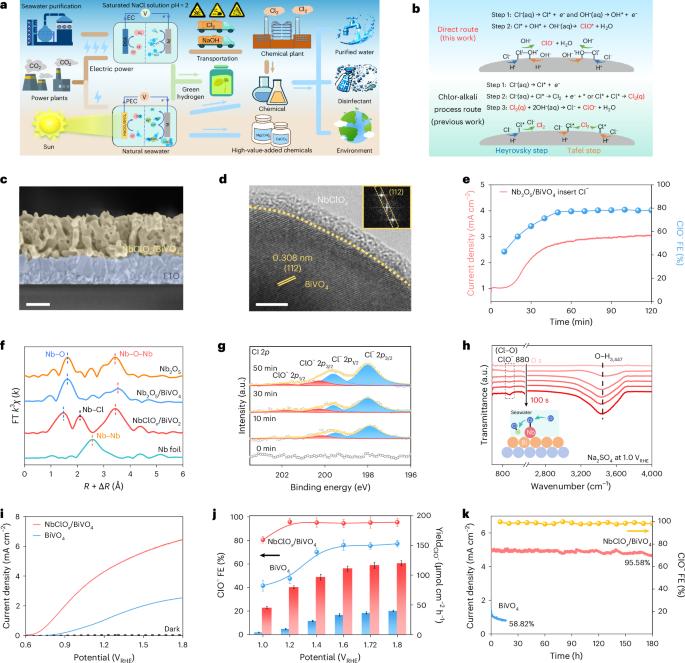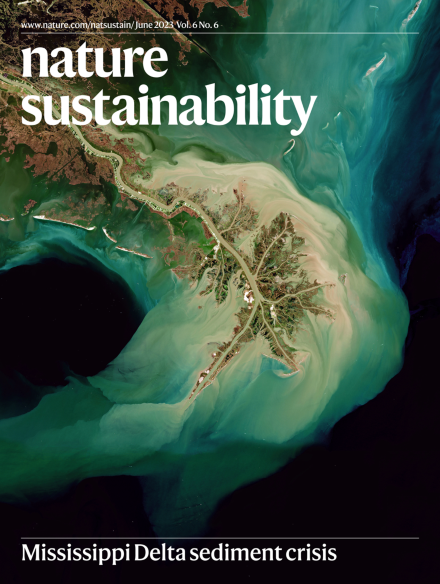Photoelectrochemical production of disinfectants from seawater
IF 27.1
1区 环境科学与生态学
Q1 ENVIRONMENTAL SCIENCES
引用次数: 0
Abstract
Active chlorine, including HClO and ClO−, is one of the most extensively used disinfectants. However, it is mainly produced through energy-consuming three-step chlor-alkali electrolysis of saturated brine using Cl2 gases as intermediates. Here we report a photoelectrochemical synthetic pathway from natural seawater using a chloride-mediated NbClOx/BiVO4 photoanode. The photoanode presents an onset potential of 0.6 V versus a reversible hydrogen electrode (VRHE) and over 500 h of stability in seawater under one sun illumination. The faradaic efficiency and selectivity of hypochlorite are close to 100% at 1.2–1.8 VRHE with a yield of 119.9 ± 9 μmol cm−2 h−1 at 1.72 VRHE. Meanwhile, value-added products of Mg(OH)2 and CaCO3 are obtained on the cathode, accompanied by hydrogen production. Further analyses show that the present process reduces electricity consumption by 77.16% and CO2 emissions by 75.31%. Our findings suggest a strategy with combined safety, efficiency and economic feasibility for direct synthesis of active chlorine from seawater. Active chlorine is the most widely used water disinfectant, but its production has environmental consequences. This work shows a photoelectrochemical synthetic route using only solar energy and seawater.

海水消毒剂的光电化学生产
活性氯,包括HClO和ClO−,是使用最广泛的消毒剂之一。但是,它主要是通过耗能的三步氯碱电解饱和盐水,以Cl2气体为中间体生产的。在这里,我们报道了一种利用氯化物介导的NbClOx/BiVO4光阳极从天然海水中合成的光电化学途径。与可逆氢电极(VRHE)相比,光阳极的起始电位为0.6 V,在一次阳光照射下在海水中稳定性超过500小时。在1.2 ~ 1.8 VRHE条件下,次氯酸盐的法拉底效率和选择性接近100%,在1.72 VRHE条件下的产率为119.9±9 μmol cm−2 h−1。同时在阴极上获得了Mg(OH)2和CaCO3的增值产物,并伴有制氢。进一步的分析表明,目前的工艺减少了77.16%的电力消耗和75.31%的二氧化碳排放。我们的研究结果为从海水中直接合成活性氯提供了一种安全、高效和经济可行的策略。活性氯是应用最广泛的水消毒剂,但其生产会产生环境影响。这项工作展示了仅利用太阳能和海水的光电化学合成路线。
本文章由计算机程序翻译,如有差异,请以英文原文为准。
求助全文
约1分钟内获得全文
求助全文
来源期刊

Nature Sustainability
Energy-Renewable Energy, Sustainability and the Environment
CiteScore
41.90
自引率
1.10%
发文量
159
期刊介绍:
Nature Sustainability aims to facilitate cross-disciplinary dialogues and bring together research fields that contribute to understanding how we organize our lives in a finite world and the impacts of our actions.
Nature Sustainability will not only publish fundamental research but also significant investigations into policies and solutions for ensuring human well-being now and in the future.Its ultimate goal is to address the greatest challenges of our time.
 求助内容:
求助内容: 应助结果提醒方式:
应助结果提醒方式:


